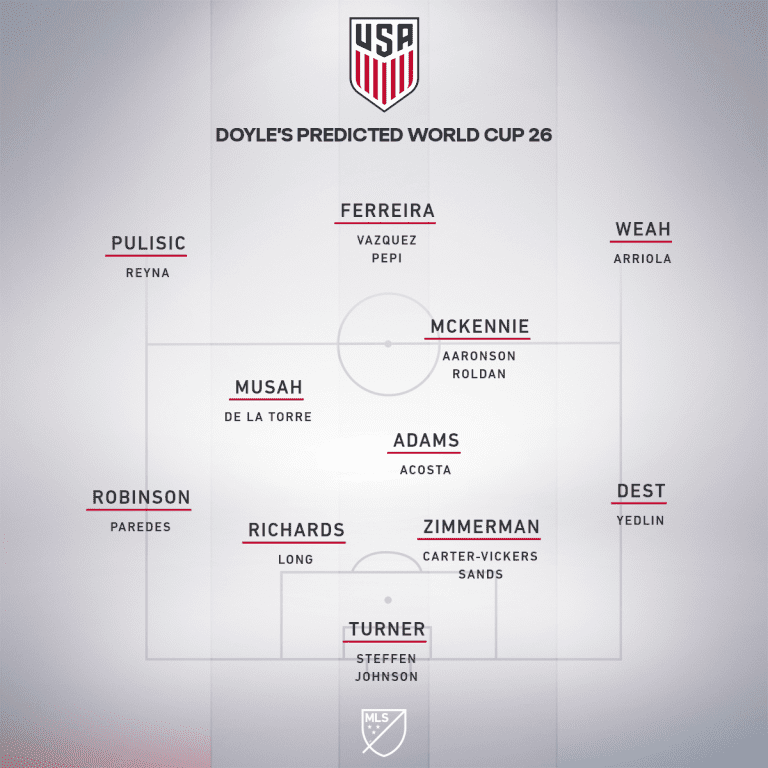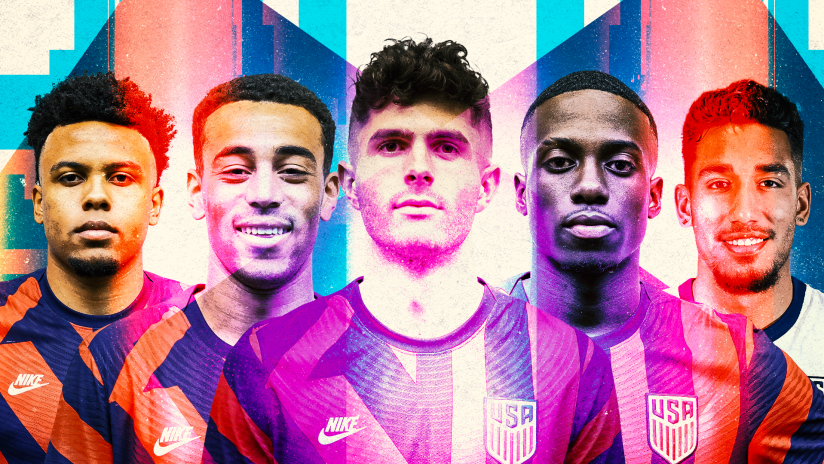The US men’s national team’s June camp is in the books. Now, instead of counting the days/weeks/months until this autumn’s World Cup, we’re counting the minutes. There are just 180 of them left.
So this was the bigger and arguably more important of the two post-World Cup qualifying camps. It gave head coach Gregg Berhalter a chance to both solidify the core of the roster, while at the same time introducing some new tactical concepts. We now know:
- The top two players on the depth chart at virtually every position, bar center forward and left back.
- At least two different formational/tactical tweaks Berhalter’s got up his sleeve.
- Perceived shortcomings of a few of the starters and how Berhalter is willing to adjust for that.
In all, the guys who came into camp that we were all pretty sure would be invited to the next one, and then the next one after that (which is, you know, the actual World Cup) all played fairly well. There was not an instance of a regular, or a perceived regular, playing himself off the roster. Instead, guys like Luca de la Torre, Jesus Ferreira and Aaron Long played at a level that almost certainly puts them on the plane – which is where every sane person thought they’d be in the first place.
The flip side is we didn’t really see any of the newcomers make a particularly great case for themselves. Cameron Carter-Vickers (as of now I’ve got him on the plane) probably comes closest, but that’s more by default after Erik Palmer-Brown’s disaster class against Uruguay and the fact that neither Mark McKenzie nor James Sands were invited in the first place. Meanwhile guys like Joe Scally and Haji Wright… ooof.
With that in mind, let’s go through what we saw:
Stock Up
If the World Cup started tomorrow, he’d be the US’s starting No. 9. And while I understand there’s a level of frustration that he’s not been particularly consistent in front of goal, the fact is he finds high-quality chances no matter whether he’s playing Grenada or Uruguay. And then there’s the knock-on effect of his presence in the lineup – the US, as a whole, seem to play better when he’s out there. We saw that in the difference between the first and second halves of the El Salvador game on Tuesday night.
Bear in mind, though, that while the FC Dallas star is a lock for the roster I’m still not convinced that he’s a lock to start.
Luca had been very good-to-excellent every time he stepped on the field in qualifying, though I think there were some reasonable worries about him heading into this camp based upon how he’d ended his season with Heracles (he was particularly poor in the Dutch relegation playoffs, and was actually subbed out of the second leg).
Those worries are dead and buried. De la Torre is on the plane, 100%, as a direct back-up for Yunus Musah. And given that Musah’s not exactly a 90-minutes-every-time guy, it’s a good bet that we’ll see him on the field at some point in November.
Had a few rough moments, but he played more minutes than any other CB on the roster this month, and got stronger as the games went on – he was particularly good in the second half against El Salvador with both his distribution and his ball-winning.
Did his stock rise enough to be considered the No. 2, over the healthy version of Chris Richards? I don’t think so. But Long’s for sure on the plane now, and I wouldn’t necessarily have said that a month ago.
Carter-Vickers wasn’t great, and I think it’s pretty clear that Berhalter doesn’t trust him the way he trusts Long (which is understandable given that CCV’s been on the outside looking in for years). It’s telling that CCV was subbed off for the final, frantic 10 minutes in El Salvador even though he’d been very good in that game to that point.
But overall I thought he did make a compelling case for himself as the fourth center back, and avoided the types of errors that have plagued the other guys in the running for that particular job.
Musah wasn’t perfect – we’ll get into some detail on that below – but he is the most dynamic central midfield ball-carrier the USMNT has ever had. Ever. Ever. Ever.
Whether it’s a 4-3-3 or a 4-2-3-1 or a 3-5-2, he’s a starter. Write it in pen.
Johnson wasn’t originally on the roster, and was only added late in the game after Zack Steffen had to withdraw for family reasons.
He was there for more than just making up the numbers, delivering a Man of the Match masterclass in the shutout of Uruguay. I’ve got to say that I think there’s a stronger argument for him to be No. 2 on the depth chart than No. 4.
Stock Down
The big No. 9 played 118 minutes across three games and offered… not much. That, sadly, is in line with his underlying numbers from Turkey, which suggested he wouldn’t bring much to the table other than the occasional ability to find a high-quality chance.
He was yanked at the half of his one start. The US subsequently played better with him off the field, and then this happened in the postgame:
The last player I can recall Berhalter criticizing so sharply was Konrad de la Fuente. Konrad hasn’t seen a single camp since.
Scally’s hot start in the Bundesliga seems oh so long ago. Instead of that dynamic two-way player, what the US got in his one start was the version of Scally that was mostly a depth piece in the new year – a technically limited and tactically naive young player who ended up getting lost on simple rotations, and targeted more often than not.
I think he’s further from the final roster after this camp.
The same is probably true of Bello, who managed to get onto the field for just 30 minutes against the 170th-ranked team in the world and was… ineffective. That matches his performance with Arminia Bielefeld, who were relegated to Germany's second division.
The book isn’t closed on either Scally or Bello – nobody else has stepped up and shown they’re the obvious choice to back up Antonee Robinson, and either/both could play their way into that role with a good start to this coming season in Germany.
But it didn’t happen like that for either in this camp.
I debated putting him here given that his flexibility (he can play as either a right back, a right wingback or a right center back in a back three, which is how he was primarily used in this camp) is an asset. But how much does versatility matter if you don’t play well?
Cannon mostly did not. Over the past few years Berhalter has tended to trust DeAndre Yedlin more than the other backup RB options (Sergino Dest is obviously the starter) against quality competition, and that held true again in this camp. Cannon didn’t really provide a reason for Berhalter to change his mind.
Had a miserable 45 minutes against Uruguay, then picked up a slight hamstring knock and didn’t get on the field again. Made Carter-Vickers, who I think he was in direct competition with, look like prime Cannavaro.
Over the course of his career, Horvath has had a knack, at the club level, for committing spectacular blunders that cost him his job. As so.
He’s got to find a place where he can start and get weekly games.
Just 30 minutes against Grenada and, like Bello, he wasn’t great in them. Roldan might be the US version of his Peruvian club teammate Raul Ruidiaz – a superb player who just can not figure it out for their respective national teams.
For what it’s worth I still think he’ll make it as the 26th man on the roster, but guys like Paul Arriola and Jordan Morris are clearly ahead of him in the pecking order at Roldan’s best spot (right wing), and if you move him to the interior, I think a healthy Djordje Mihailovic is probably ahead of him on the depth chart there. And Roldan didn’t do anything over the past three weeks to show it should be otherwise.
Who Benefitted?
In light of the struggles of the above group, I’m adding another category: guys not called into camp who benefitted from the subpar performances of the guys listed above.
Literally every striker conceivably on the depth chart but not in camp got a stay of execution thanks to Wright’s performance. Force me to pick one to put my money on, and it’s Brandon Vazquez. Here’s a clip:
Reminiscent of Christian Pulisic’s touch vs. Morocco, right?
Here’s one from this year:
This is a very different type of goal from the one above, and a very different type of goal from the ones that Ferreira tends to score. Vazquez is a classic center forward who’s phenomenal at making the types of double moves that separate the center backs and create a few yards of space in the box, and is dominant in the air once he gets service.
The other thing to note here: Vazquez draws a ton of fouls. In 1068 minutes this season he’s been fouled 23 times while Ferreira, meanwhile, has drawn just four fouls in 1112 MLS minutes (and just two in his last six USMNT outings). Ricardo Pepi, in 2100 minutes last season, drew 19 fouls. For a team that projects to be very good on attacking set-pieces, that’s significant.
I think Berhalter namechecked him in a pre-camp interview for a reason. I also think that if he keeps playing the way he has (bear in mind that in addition to all of the above, he’s probably the second-best pressing center forward in the pool behind Ferreira), he’ll be on the roster in September.
Palmer-Brown’s struggles keep the door open for these two guys, both of whom played significant roles in 2021, but both of whom fell down the depth chart due to struggling with their new clubs in Europe.
The door could have shut on them. Instead, it’s wide open. They just need, when the season starts, to play often and well.
Same principle as with Sands & McKenzie, except in this instance it was Scally and Bello leaving the door open.
I don’t think Jones has been quite as good for the Revs as he was last year, and Paredes, upon moving to Wolfsburg, played even less than Bello did for Bielefeld. But I think the door is still open for either to stake a claim as Jedi’s back-up ahead of the guys who’ve already been given chances and, frankly, found wanting.
What else we learned
I wrote at length last week about Berhalter’s employment of a double pivot, and the US’s building out of a 4-2-3-1 shape and into a 3-2-2-3 when in possession. My speculation at the time was that this had to do with Tyler Adams’ limitations as a tempo-setter from the d-mid spot (there’s a reason the US progressively played more against the ball while sticking to the single pivot throughout qualifying), and that the point was to get Musah (or de la Torre) on the ball deeper and earlier in possession sequences in order to sort of paper over Adams’ limitations.
In the 42nd minute of the Grenada game, Jon Champion and Taylor Twellman confirmed that guess on the ESPN broadcast.
"When we asked [Berhalter] about the change in the shape... he talked about Adams, and in some sense he was saying there are occasions, in that single pivot role, where Adams hadn't got the job done,” Champion said. "He hadn't done what Gregg Berhalter requires of the man in that position, and that's why he's slightly tinkered with the shape of the midfield."
In several very big ways, it worked. Musah’s ability to progress the ball from back-to-front led to the US’s best chances against Uruguay, and a handful of excellent moments against Morocco:
There are downsides, though. Going to a double pivot frees Adams to play as a two-way destroyer rather than purely as a backline protector, and when Adams plays on the front foot like that, he’s going to press.
The issue is not everyone was reading the same pressing triggers he was. In this clip, Pulisic is lost between two options, which allows a massive cross-field switch that puts Morocco on the front foot at a canter, and Musah… never rotates. If you’re going to play in a double pivot you have to be aware of the defensive responsibilities built into the system, and Musah struggles badly with that at the moment:
With Adams and Musah both on the bench and Kellyn Acosta into the XI against Grenada it was back to the good old 4-3-3 with the single pivot. But then against El Salvador with both Adams and Musah back into the XI, the US went back to that 4-2-3-1 with the double pivot.
It did not work. I think there are a lot of reasons for that – Brenden Aaronson is not great in central midfield in any system that asks him to find a lot of the ball; Cannon struggled to provide any sort of useful width up the right; Wright was invisible; the field was a soaked paddock – but regardless, it was a pretty limp half of soccer.
What I did not expect to see was Berhalter’s adjustment. Wright and Aaronson came off for Ferreira and Weston McKennie and the 4-2-3-1 became a 3-5-2. Cannon, Carter-Vickers and Long were on the backline, with the MMA midfield. Jedi was the left wingback with Weah – positioned higher than Jedi – as the right wingback. Ferreira operated as a true No. 9, while Pulisic was more of a trequartista who tilted towards the left side.
You can get a feel for the new shape from this sequence, which started less than 60 seconds into the second half:
That is a new shape for the US. It’s not night-and-day from what they’ve been doing for the past few years under Berhalter, and it’s similar in some ways to how the US played against Morocco, which also featured Cannon in a RCB role. But it’s pretty different in that I don’t think anyone was specifically rotating into the pockets. It was more about pinning La Selecta high and wide with a true 9 and two wingbacks, and then letting McKennie, Musah and Pulisic sort of find the game. It felt less scripted than previous iterations of the US attack.
Maybe it’s a one-off, something that can be chalked up to the level of competition and the conditions of the field. Or maybe it’s something that Berhalter’s got up his sleeve for November.
I don’t expect Berhalter, if asked, to answer that question with any real candor. But I’m already looking forward to September camp not only to see how the few remaining roster battles play out, but also to see if the shape variations we got a taste of this month were a sign of things to come.
Projected 26-man World Cup Roster



























